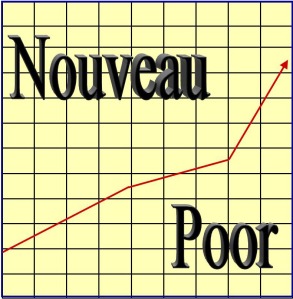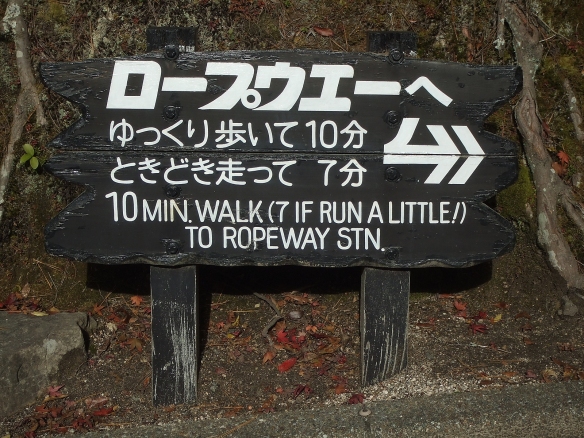 I want to offer my thanks to the readers of the Nouveau Poor and the American taxpayer. For the past several months you’ve been helping to buy my groceries. But I’m relieved to tell you that business has now recovered enough that we are back on our feet and ready to totter forward.
I want to offer my thanks to the readers of the Nouveau Poor and the American taxpayer. For the past several months you’ve been helping to buy my groceries. But I’m relieved to tell you that business has now recovered enough that we are back on our feet and ready to totter forward.
The past few years have been extremely difficult. Because of you, our family has had one bright spot in our daily life—the knowledge that we could afford food. When you can’t afford anything else, your next meal becomes incredibly important.
I’m happy to say the safety net worked like it should. Your help not only got us through some impossible months, it saved the jobs of our remaining employees, so their families could keep eating also. Still, when over 46 million Americans are on food stamps—one of every seven people in the U.S.—you know something is wrong. When the number of people receiving food assistance rises more than 70% in four years, and the cost of the program reaches $72 billion, you realize the system is broken.
But it’s fair to ask which system. While I’m very grateful for the assistance, I would have been even more grateful for a solution that made food stamps unnecessary. Since October, we’ve received nearly $5,000 in assistance or $687 per month for a family of four. Of this, we spent about $3,700. How much better would it have been to lower our taxes that amount so we didn’t need food stamps? Or how about removing the government’s foot from the neck of business so that buyers and sellers could make rational decisions? How about stripping out the endless regulations and requirements that make it almost impossible to make a profit if you’re a small business owner? How about not using businesses as the faceless cash cow for every harebrained scheme to come out of Washington? “Tax the rich” sounds great until you end up with no jobs.
I’ve tried to convey in these posts over the past months what it’s like to walk into a grocery store and buy food with an EBT card—all the while knowing that the cashier and the people in line behind you are eyeing your purchases and evaluating the worth of your clothes and your car. Those critics constantly whisper in my head. I can hear them now saying that if I didn’t like using food stamps we should have quit being leeches and gotten jobs—as if it’s that easy. Never mind that approximately 41% of the people on food stamps, including us, already live in working households.
Many people complain that the system is corrupt and riddled with fraud. And I’ve tried to be honest. Food stamps do warp buying decisions. The money comes at no cost except to dignity, and you don’t get to keep what you save—any money that isn’t spent rolls over, but at the end of the day the savings go back to the government. That makes it hard to be conscientious. Only the benefit amounts and a person’s own ethics act as a brake.
That said, many of the current proposals to “fix” the food stamp program are expensive and/or damaging. Some states have proposed limiting the types of food that can be purchased. But determining what to allow and policing such a system is costly. Others states, like Pennsylvania, have instituted asset testing, which makes sense as long as the asset limits are reasonable. If you force a family to sell a car they need to get to a job or look for work, how does that help taxpayers?
Other proposals include requiring photo identification on EBT cards, instituting a work or volunteer requirement (which would penalize job seekers and parents) and drug testing recipients, which besides being demeaning would be too expensive to be worthwhile. A more targeted approach might be to test only those who request replacement cards.
None of these solutions address the real problem: Taxpayers don’t want to see the person next to them getting for free what they have worked for. If you ask 10 people if they are willing to help the poor, nine of them will say yes. But if you take those same nine people to Wal-Mart and show them a woman (or man) using an EBT card, the majority will be outraged by something the person is buying, by her clothes or haircut or the number of children surrounding her or by her car. They will be sure the person is abusing the system.
Again, they’re focusing on the wrong issue. Food stamps are a blessing when you can’t afford food. Are they the right solution? I still don’t think so. Fix the country’s economic woes, and the majority of people receiving food stamps will be able to solve their own money problems. Lower taxes. Reduce regulation. Encourage education.
It’s hard to make the decision to go off food stamps. It’s hard to give up that safety in the face of uncertainty. The construction industry is showing faint signs of life, following the rest of the limping economy, but it’s far from certain that business will continue to move in the right direction. Much of Europe is back in recession, and the U.S. economy shows many troubling signs as well.
So we make this decision with trepidation. On the one hand, walking into a grocery store and paying for our own food will be a huge relief. On the other, the thought of going back to the days of walking out with as little as possible is daunting. But it’s the right thing to do.
I worry about the lessons my kids are learning. Will they decide there’s no point to saving money and working hard? Will they conclude that a college degree is a waste of time? I’ve wondered all those things the past few years. How has reading or overhearing the negative comments about welfare affected my children? What have they made of our choices with food stamps? For example, when they ask why we can’t buy ice cream or cookies, do they understand our decisions? How do they account for the fact that we’ve told only a handful of family and friends about being on food stamps?
I hope they take away some positive lessons: Help is available if you need it. People can be wonderfully kind and generous. You don’t need the latest gadgets and new clothes and entertainment to be happy. We have gotten good at re-creating foods we used to buy out and at baking our own treats. When you can’t afford any entertainment or extra expenses, being able to make a batch of cookies may be the bright spot of the week. And a packet of oatmeal eaten in a tent is more fun than any fancy breakfast at a restaurant.
This will be the final post for the Nouveau Poor as we re-join the self-sufficient. I want to thank my readers for your comments and encouragement and your own amazing stories. I’ve learned much and been given much to think about. I hope I’ve done the same for you, and I wish you all the greatest success.—The Nouveau Poor


 The Great Recession has taught many lessons, and as someone who has not escaped unscathed, here are two conclusions I’ve reached about college:
The Great Recession has taught many lessons, and as someone who has not escaped unscathed, here are two conclusions I’ve reached about college:









